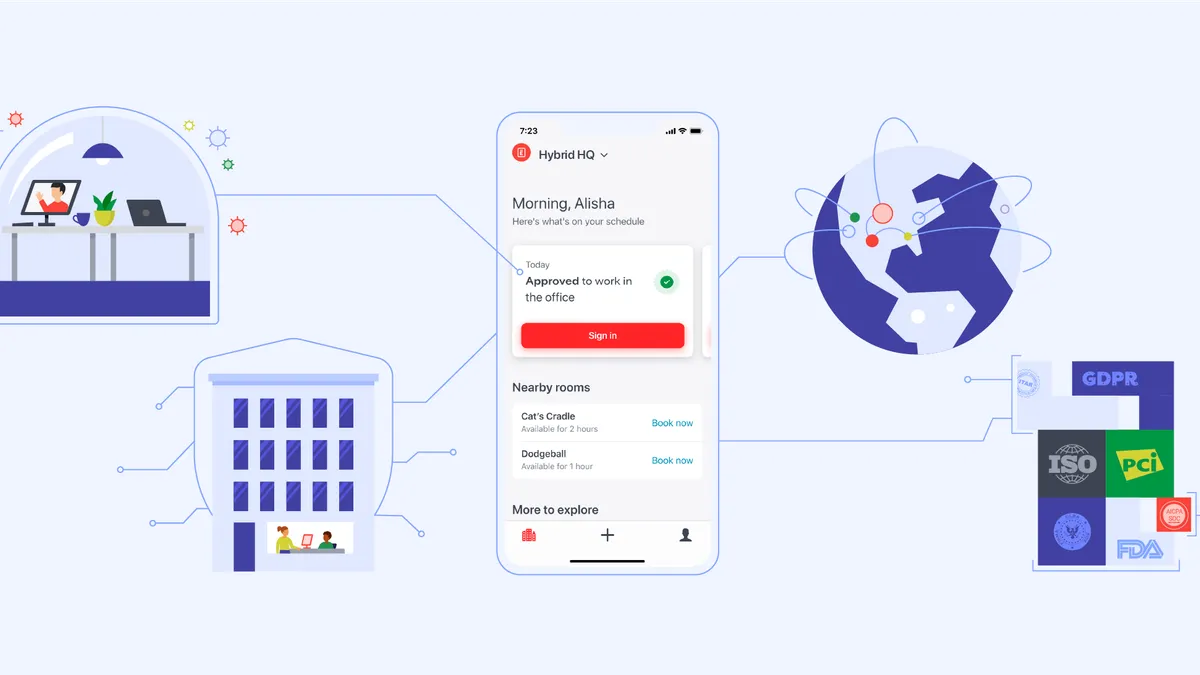Ready or not, hybrid work is here. And it's scaling fast. As much as we've been loving our virtual Zoom backgrounds, employees are itching to return to the workplace, at least some of the time: 48% want to work between 1 and 4 days on-site. That said, people expect their companies to have protocols and technology in place to not only keep them safe but also to enable productivity regardless of physical location. IT leaders play a critical role in implementing technology that connects the workplace and encourages on-site collaboration.
Welcome visitors back safely
All types of people come in and out of the workplace. Employees, contractors, clients, interview candidates, maintenance personnel, vendors, and more. It's always been important to keep track of everyone who enters your building. The shift to hybrid work makes visitor management not only more crucial but also more complicated.
Safety protocols have increased in the wake of the pandemic, and so have safety concerns. A staggering 66% of employees worry about returning to the workplace. They're worried about who else might come in and put their health at risk. Implementing a visitor management system (VMS) can ensure everyone who comes on-site is cleared to do so. There are even ways to automatically verify vaccination status before arrival. Health screenings confirm that people are symptom-free before coming to the workplace and give on-site employees the peace of mind they need to focus on work. Contagious diseases are not the only intruders you need to fend off. As an IT leader, you're no stranger to data security threats. The flexible, back-and-forth nature of hybrid work makes it harder to track who accesses data from what system, on what device, and why.
Prevent unauthorized entries by integrating your VMS with your existing access control system, and protect your network with secure WiFi access granted only upon check-in.
Hybrid work happens outside the workplace, too. For every person checking in on-site, there's another at home, working remotely in a dress shirt and pajama pants. While you can't control remote employees' fashion choices, you can control how vulnerable they are to cyberattacks. All too often, personal computers become infected with viruses or homes run on outdated routers, posing a security risk. So it doesn't come as much of a shock that the number of cybercrimes reported to the FBI has doubled since the pandemic.
To combat this, many IT leaders have doubled down on measures to protect data stored across devices, networks, and the cloud. These measures include multi-factor authentication (MFA), encryption, tokenization, and recovery systems. Maybe you already have these measures in place, maybe not. Just be sure that as you transition to hybrid, so does your security strategy—and the technology supporting it.
Motivate employees to use new technologies
Of course, it doesn't matter how many flashy features a technology has if no one in your workplace uses it. Employees are more likely to use a new system that fits in seamlessly with the tech they're used to working with already, like smartphones, Slack, or Teams. Boost adoption with a solution that lets employees connect whenever and however they need to. Including face-to-face. Most employees plan to base their on-site schedules around the people they want (or need) to work with. In fact, 87% of employees cite collaboration and relationship building as the top needs for a physical space.
A workplace platform makes it easy to see who's coming in and even invite coworkers to join an ad hoc meeting day-of. When you implement intuitive systems that power a people-centric workplace, everyone wins. More productive, happy employees doesn't just mean better company performance—it also means fewer tech support tickets flooding in for your team.
Choose a platform that scales with your company
No matter how much your employees might love new software, you shouldn't have to uproot your existing workflows just to implement it. Instead, find a hybrid work solution that's interoperable with your existing systems. After all, your team wants technology that fits in with their life. Ideally, instead of adding steps, your hybrid work software should consolidate and simplify operations—at scale.
You don't have the time to implement every new system into each office location. You deserve a technology built with enterprise needs in mind. A platform that can be deployed easily across all locations, and managed in one centralized place. The most robust hybrid work solutions let you view global settings and analytics in one centralized dashboard. This empowers your company to expand confidently, making a few cost-cutting decisions along the way.
The journey to hybrid productivity begins with IT. The flexibility, efficiency, and employee happiness generated by a hybrid work environment is only possible with the right technology in place. When it comes to building the infrastructure for modern productivity, we look to you.
Learn more about the technologies that support hybrid work. Read our ebook, The guide to the connected workscape.










